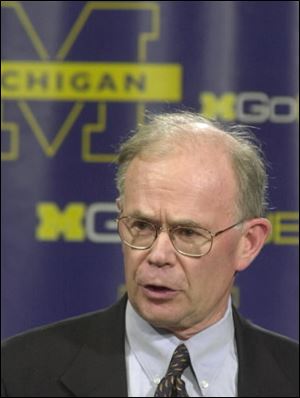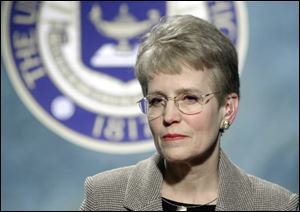
Old-school views clash with plan to upgrade UM football stadium
12/3/2006
An artist's rendering of the renovation project of Michigan Stadium which is intended to bring the stadium in line with what comparable venues around the country offer.
ANN ARBOR At the University of Michigan, The Big House, home to the highly successful Wolverines football team, is a massive bastion of a bygone era.
Today, Michigan Stadium is essentially the same deep bowl, filled with concentric rings of benches, that legendary coach and athletic director Fielding Yost envisioned more than 80 years ago when he pitched the idea of building a mega outdoor arena, long before mega was even part of the vernacular.
But at Michigan, where they don t follow the academic curve, they often establish it. And while research and work in nanotechnology, nuclear engineering, and radiological sciences here is all cutting edge, the football stadium clearly is not.
Recently, the University of Michigan Board of Regents moved closer to firing up the backhoes and assembling a legion of brick masons for a $226 million renovation project by giving it a preliminary approval.
So the most recognized icon on the historic campus soon will likely undergo some major changes, and not everyone in the Wolverines family is pleased with the prospect of a new-and-improved Michigan Stadium.
The venture is intended to bring Michigan Stadium in line with what comparable venues around the country offer in terms of amenities and luxury seating options.
The current dispute swirling around the revered old stadium amounts to a philosophical tug-of-war, with one side advocating substantial changes that would put Michigan Stadium more on a par with facilities at other Big Ten institutions.
The opposing viewpoint is stridently aired by a number of Michigan alumni who see the project as an abandonment of tradition.
Some object to it for aesthetic reasons, seeing the construction of towers full of plush, luxury suites rising above the staid, aging stadium as akin to letting LeRoy Neiman gussy up the ceiling of the Sistine Chapel with splashes of brilliant color.
The designs approved by the board call for the addition of two multistory masonry edifices, on the east and west sides of the stadium, to house about 80 suites and 3,200 private club seats.
If final approval is received early next year, the project is expected to be completed prior to the start of the 2010 season and not interfere with the Wolverines home schedule during construction.

UM Athletic Director Bill Martin says the stadium is urgently in need of an upgrade in its basic amenities.
Controversy revisited
Mr. Yost coached football here for a quarter of a century and then, in his role as athletic director, proposed a stadium that would seat upward of 150,000, an idea that ignited a major debate on campus.
Some liked the concept of a huge facility that would accommodate students, alumni, and the general public en masse. Others cringed at the notion of making football the centerpiece, considering it a threat to the university s academic and intellectual standing.
The new proposed project is equally controversial.
It is expected to be funded with private donations and resources from within the athletic department, consisting primarily of the fees generated by leasing the loges and club seats, according to Michigan Athletic Director Bill Martin.
An updated vision
Mr. Martin favors a better, slightly bigger Big House. He points out that the stadium is urgently in need of an upgrade in its basic amenities, and that the onus is on the current administrators at UM to seek an appropriate remedy.
The wish list includes wider aisles to better deal with crowd flow; improvements to existing restrooms and additional restrooms; modern concourse areas, and improved seating options for fans with limited mobility.
We have to address these issues, Mr. Martin said, and improve this great stadium for everyone.
He added that the designs would be consistent with the tradition on campus, and any interested parties have been provided the opportunity to air their suggestions or comments on the proposed renovation.
This is a very large project and one that we want to do right, down to the smallest detail. We are being careful with everything before we go forward, he said.
The discussions and debate over improvements and/or renovations to Michigan Stadium have taken place over a long period, and meanwhile, Mr. Martin said, the 80-year-old structure has become increasingly physically obsolete, much like the 150-pound linemen who played here in the stadium s early days.
Others resist the addition of the pricey loges, which they see as an embarrassing departure from the egalitarian principles the university is supposed to champion.
Another view
A group called Save the Big House has pitched a more limited renovation that eliminates the private boxes but adds 15 rows of bleachers around the rim of the bowl and improves the aisles and restrooms and the facilities for the disabled. They estimate that the $66 million cost of their proposed project could be covered by increased ticket sales, since their plan would bump the stadium s capacity to 117,001.
In addition, members of the Michigan Paralyzed Veterans of America have voiced concerns that the stadium renovation outline approved by the regents would not adequately accommodate the needs of the disabled.
University President Mary Sue Coleman said she is thrilled with the regents proposed changes to Michigan Stadium and pleased with the prospect that after the costs of the renovations and additions are covered, the revenue streams from the new luxury seating areas would help enhance the facilities and cover the costs involved with the school s more than two dozen other men s and women s varsity teams.
In addition to funding improvements to the game-day experience for all fans, Ms. Coleman said, this project will provide a strong financial foundation for the competitiveness of Michigan athletics in the decades ahead.

UM President Mary Sue Coleman says she is thrilled with the regents proposed changes to the stadium.
Priorities questioned
Longtime Michigan fan John F. Krzysiak thinks the cost of the project will increase substantially before it is done; he bristles at the concept of adding plush, expensive suites to the stadium.
Mr. Krzysiak, a retiree who grew up in the Detroit area and worked in the publishing business, would like to see the money spent elsewhere at UM, in hopes of injecting some life into the sagging economy of the region by establishing an internationally recognized technology hub.
I think it is a shame that $300 million will be spent to accommodate only the well-to-do, Mr. Krzysiak said.
I wonder what those dollars would do for Michigan and the University of Michigan if they were awarded to the most gifted math and science students from across America. This state is in dire need of a technology base to replace the diminishing automotive industry here. Such a move would ultimately benefit the Toledo area too, he said.
Keeping pace
Rick Kusmer, an ardent Wolverines follower and a senior project manager for Fremont-based Mosser Construction Inc., said the renovation is long overdue and that Michigan must upgrade to keep pace with the rest of the conference. Numerous supporters of the project have mentioned rival Ohio State s addition of 81 luxury suites and 2,500 club seats and the perceived advantage that gives the Buckeyes.
We have to keep up, Mr. Kusmer said. I know the traditionalists say, Oh my God, it s a sacred institution, but that s not realistic. Everybody else has these suites as a selling point for recruits and as a revenue producer. Ohio State s got them, Penn State, the major college football programs all have them.
Mr. Kusmer said that if the UM Museum of Art received a new collection and needed an additional wing in which to house it, it would not refuse the collection but would instead expand the existing building while preserving its style and flow. The athletic department can do the same thing with the Big House, he said. You can complete this project and protect the architectural integrity at the same time, and I trust Michigan to do that.
Dick Kudner is a 1950 graduate of Michigan whose father was one of the original bond holders when Mr. Yost financed the first stadium project. The Perrysburg resident s parents both graduated from UM, along with his brother and sister, his wife, and his wife s father. Mr. Kudner has been a Michigan season ticket-holder for decades.
This place hasn t changed much since I was in school, and this kind of thing is long overdue, he said.
They ve added seats over and over, but they haven t really improved the facility much at all. It s still a marvelous place to see a football game, but everything around that experience needs to change.
Mr. Yost got a low-cal version of his original concept for Michigan Stadium, which opened in 1927 as the largest college facility in the country, seating 72,000. In the eight decades since, the capacity of The Big House has been augmented eight times to its current 107,501 still tops in the nation but not a whole lot else has changed significantly.
No one is certain where the ghost of Mr. Yost is aligned as debate over the stadium s profile and role continues, but his most prominent descendant is clearly against a major overhaul
Fielding Yost III, a Midland, Mich., resident who holds a master s degree in public policy from the school his grandfather put on the national football map, has said he abhors the luxury box concept and supports Save the Big House.
This report includes information from The Blade s wire services.
Contact Matt Markey at: mmarkey@theblade.com